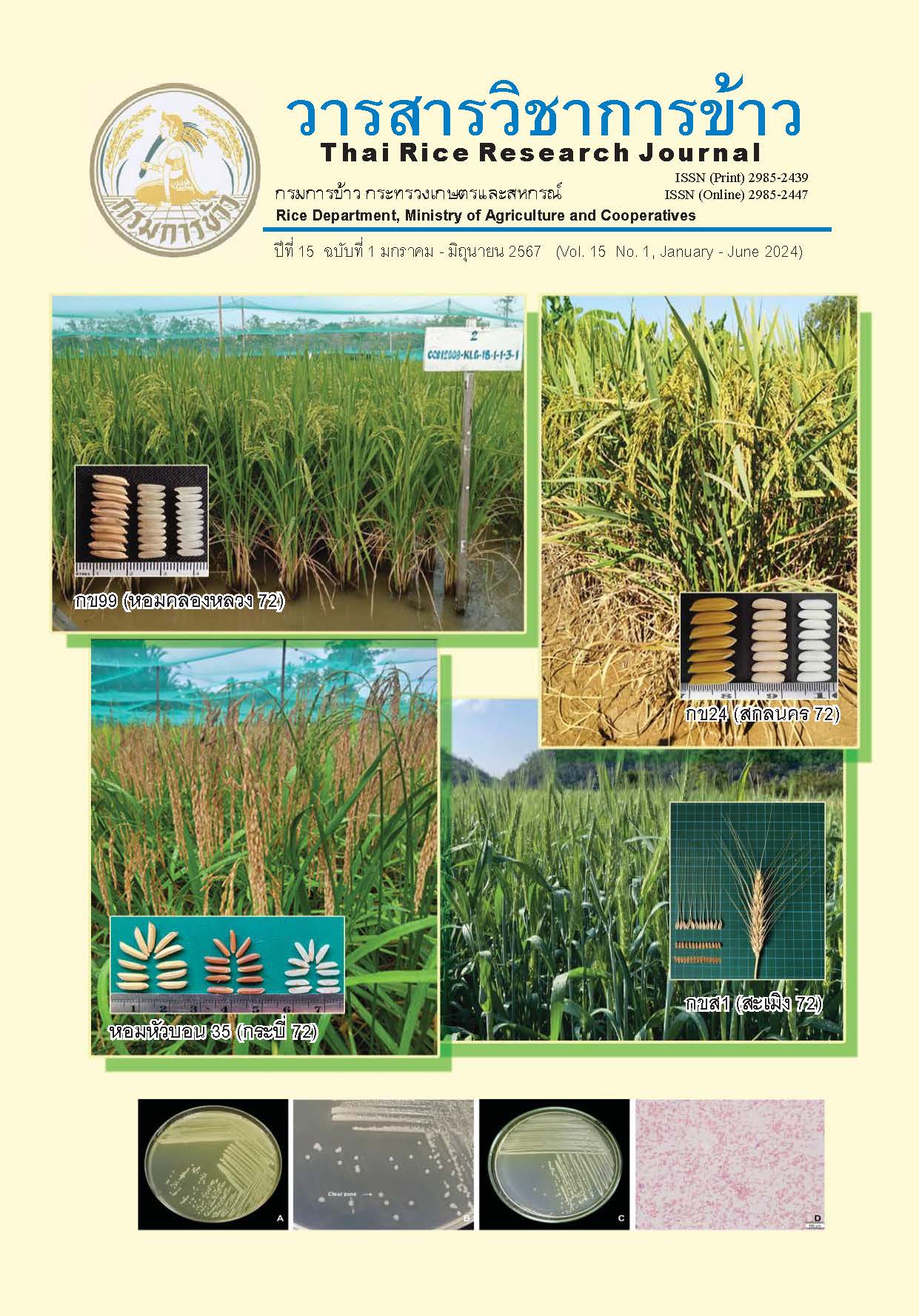RD24 (Sakon Nakhon 72), a Glutinous Rice Variety
Main Article Content
Abstract
Nowadays, glutinous rice production in Thailand is mainly consumed domestically, as only 9% is exported. RD6 is the most popular variety because of its outstanding cooking quality with aroma. However, this variety is tall, vulnerable to lodging, susceptible to blast disease, and low yield potential. Though, the release of RD18 with resistance to rice blast disease but still having tall stature and lodging leading to low yield potential. Recent collaborative research between the Rice Department (RD) and the National Center for Genetic Engineering and Biotechnology (BIOTEC) has developed a new variety with semi-dwarf plant type, lodging tolerance and blast disease resistance better than RD6 and RD18 while remaining good cooking quality. A single cross between a glutinous rice line RGDU07585-7-MAS35-4 (a semi-dwarf variety with blast disease resistance and bacterial blight disease resistant genes) as a female parent, and RGDU07123-12-22-5 (a tall variety with broad-spectrum resistance to blast disease with outstanding cooking quality) as a male parent. The promising line named RGDU10017-1-MAS-49-4-1-NKI-1-3-1-2 outperformed other lines in the same pedigree. The average yield from multiple field trials was 663 kg/rai. In addition, this line was highly responsive to nitrogen fertilizer (potential yield at about 1,002 kg/rai), has excellent milling and cooking quality, and has resistance to leaf blast. On the occasion of His Majesty the King Rama 10’s 72nd birthday in the year 2024, this line was released as glutinous rice variety “RD24” (Sakon Nakhon 72). This variety is photosensitive, making it only able to be planted in the wet season with an optimal harvesting date of November, 23. It is a semi-dwarf variety with an average plant height of 96 cm and is lodging tolerant. The average milling head is 42.2% with the length of brown rice of 7.08 mm, 2.22 mm width, and 1.76 mm thick considered as slender shape. Though, RD24 is a non-aromatic variety but it has soft texture after cooking. It is recommended to be grown predominantly under rainfed condition in the northeastern part of Thailand where leaf blast disease always occurs. It is susceptible to neck blast disease, bacterial blight disease, rice gall midge, and brown planthopper.
Article Details
References
กลุ่มศูนย์วิจัยข้าวภาคตะวันออกเฉียงเหนือตอนบนและตอนล่าง. 2561. รายงานผลการทดลองโครงการปรับปรุงพันธุ์ข้าวนาน้ำฝนภาคตะวันออกเฉียงเหนือ ฤดูนาปี 2560. กลุ่มศูนย์วิจัยข้าวภาคตะวันออกเฉียงเหนือตอนบนและตอนล่าง, กองวิจัยและพัฒนาข้าว, กรมการข้าว. 67 หน้า.
_____________________. 2562. รายงานผลการทดลองโครงการปรับปรุงพันธุ์ข้าวนาน้ำฝนภาคตะวันออกเฉียงเหนือ ฤดูนาปี 2561. กลุ่มศูนย์วิจัยข้าวภาคตะวันออกเฉียงเหนือตอนบนและตอนล่าง, กองวิจัยและพัฒนาข้าว, กรมการข้าว. 73 หน้า.
_____________________. 2563. รายงานผลการทดลองโครงการปรับปรุงพันธุ์ข้าวนาน้ำฝนภาคตะวันออกเฉียงเหนือ ฤดูนาปี 2562. กลุ่มศูนย์วิจัยข้าวภาคตะวันออกเฉียงเหนือตอนบนและตอนล่าง, กองวิจัยและพัฒนาข้าว, กรมการข้าว. 99 หน้า.
_____________________. 2564. รายงานผลการทดลองโครงการปรับปรุงพันธุ์ข้าวนาน้ำฝนภาคตะวันออกเฉียงเหนือ ฤดูนาปี 2563. กลุ่มศูนย์วิจัยข้าวภาคตะวันออกเฉียงเหนือตอนบนและตอนล่าง, กองวิจัยและพัฒนาข้าว, กรมการข้าว. 70 หน้า.
_____________________. 2565. รายงานผลการทดลองโครงการปรับปรุงพันธุ์ข้าวนาน้ำฝนภาคตะวันออกเฉียงเหนือ ฤดูนาปี 2564. กลุ่มศูนย์วิจัยข้าวภาคตะวันออกเฉียงเหนือตอนบนและตอนล่าง, กองวิจัยและพัฒนาข้าว, กรมการข้าว. 50 หน้า.
_____________________. 2566. รายงานผลการทดลองโครงการปรับปรุงพันธุ์ข้าวนาน้ำฝนภาคตะวันออกเฉียงเหนือ ฤดูนาปี 2565. กลุ่มศูนย์วิจัยข้าวภาคตะวันออกเฉียงเหนือตอนบนและตอนล่าง, กองวิจัยและพัฒนาข้าว, กรมการข้าว. 58 หน้า.
ดารา เจตนะจิตร, นงรัตน์ นิลพานิชย์, พากเพียร อรัญนารถ, วิชิต ศิริสันธนะ, วิชชุดา รัตนากาญจน์, วันชัย โรจนหัสดิน, รัศมี ฐิติเกียรติพงศ์ และธัญลักษณ์ อารยาพันธ์. 2550. โรคข้าวและการป้องกันกำจัด. สำนักวิจัยและพัฒนาข้าว กรมการข้าว, กระทรวงเกษตรและสหกรณ์. 68 หน้า.
วัชระ ภูรีวิโรจน์กุล. 2542. ปัจจัยสิ่งแวดล้อมและการปรับปรุงพันธุ์ข้าวต้านทานโรคแมลง. ศูนย์วิจัยข้าวปทุมธานีสถาบันวิจัยข้าว, กรมวิชาการเกษตร. 200 หน้า.
สำนักงานเศรษฐกิจการเกษตร. 2564. ข้อมูลการผลิตสินค้าเกษตร. สืบค้นจาก: https://www.oae.go.th/assets/portals/1/fileups/prcaidata/files/พันธุ์ข้าวนาปี%2063.pdf. (5 กรกฎาคม 2565)
สมศักดิ์ ทองดีแท้. 2543. โรค แมลง และสัตว์ศัตรูข้าวและการป้องกันกำจัด. กลุ่มอารักขาข้าว, ศูนย์วิจัยข้าวปทุมธานี. จ.ปทุมธานี. 110 หน้า.
Heinrichs, E.A., F.G. Medrano and H.R. Rapusus. 1985. Genetic Evaluation for Insect Resistance in Rice. International Rice Research Institute, Los Baños, Philippines. 352 p.
IRRI. 2014. Standard Evaluation System for Rice (SES). IRRI (International Rice Research Institute). Los Baños. Philippines.
Kahn, R.P. and J.L. Libby. 1958. The effect of environmental factors and plant age on the infection of rice by the blast fungus Pyricularia oryzae. Phytopathology 48: 25-30.
Kasaka, T. 1969. Control of rice diseases with resistant varieties. Agriculture and Horticulture 44: 230-242.
Keller, M., C.H. Karutz, J.E. Schmid, P. Stamp, M. Winzerler, B. Keller and M.M. Messmer. 1999. Quantitative trait loci for lodging resistance in a segregating wheat x spelt population. Theory Apply Genetic 98: 1171-1182.
Koutroubas, S.D., D. Katsantonis, D. A. Ntnos and E. Lupotto. 2009. Blast fungus inoculation reduces accumulation and remobilization of pre-anthesis assimilates to rice grains. Phytopathologia Mediterranea 48: 240-252.
Lang, Y., X. Yang, M. Wang and Q. Zhu. 2012. Effects of lodging at different filling stages on rice yield and grain quality. Rice Science 19(4): 315–319.
Ou, S.H. 1984. Rice diseases. 2nd ed. Commonweath Mycological Institute. Kew Surrey. England. 380 p.
Salassi, M.E., M.A. Deliberto, S.D. Linscombe, C.E. Wilson, T.W. Walker, G.N. McCauley and D.C. Blouin. 2013. Impact of harvest lodging on rough rice milling yield and market price. Agronomy Journal 105(6): 1860-1867.
Setter, T.L., E.V. Laureles and A.M. Mazaredo. 1997. Lodging reduces yield of rice by self-shading and reductions in canopy photosynthesis. Field Crops Research 49: 95-106.

